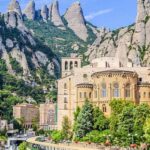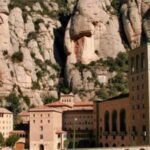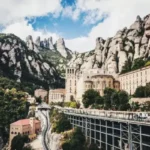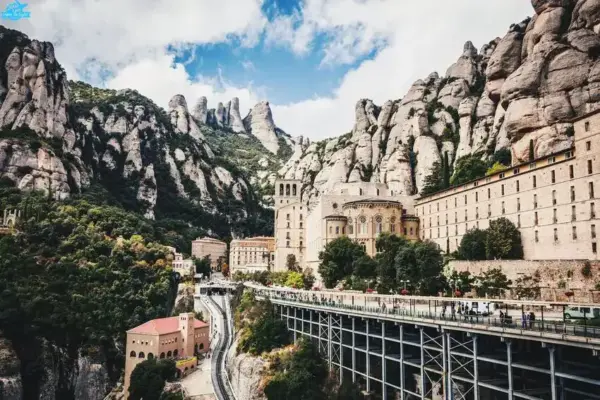
The Montserrat Monastery, perched high in the Catalan mountains, is not just a sanctuary for spiritual seekers but also a treasure trove of history. Its origins date back to the 10th century, making it a significant site for pilgrims and history enthusiasts alike.
As we delve into the past, we embark on an exploration of its remarkable heritage and cultural significance. Join us on this captivating journey, as we begin **Unveiling the Rich History of Montserrat Monastery: A Journey Through Time**, revealing the stories that have shaped this iconic landmark.
The Historical Significance of Montserrat Monastery: A Spiritual Epicenter
The Montserrat Monastery has served as a spiritual epicenter for centuries, attracting countless pilgrims seeking solace and enlightenment. Its location on the rugged Montserrat mountain range not only enhances its breathtaking beauty but also symbolizes a connection to the divine. This communion with nature has inspired many to embark on journeys of faith and self-discovery.
Throughout its history, Montserrat has been associated with several key events and figures that have shaped its identity. Some notable highlights include:
- The establishment of the Benedictine community in the 10th century.
- The veneration of the Black Madonna, a central figure in the monastery’s spiritual life.
- Its role during the Spanish Civil War, where it became a refuge for artists and intellectuals.
Moreover, Montserrat Monastery has played a pivotal role in the cultural landscape of Catalonia. It is not only a site of worship but also a repository of art and history, housing invaluable collections of paintings, manuscripts, and artifacts. These treasures reflect the monastery's enduring influence on regional culture and spirituality.
Today, Montserrat continues to be a vital spiritual destination, drawing visitors from around the globe. Its rich heritage, coupled with breathtaking natural surroundings, makes it a unique site where history and spirituality intertwine. As we explore Montserrat, we uncover layers of significance that speak to both the past and the present.
Exploring Montserrat Monastery: Architectural Wonders and Art Treasures
The architectural wonders of Montserrat Monastery are a testament to centuries of craftsmanship and devotion. The **Romanesque and Gothic styles** intermingle seamlessly, creating a unique aesthetic that mesmerizes visitors. Notable elements include the impressive basilica, the stunning cloisters, and the sanctuary that houses the revered Black Madonna, known as La Moreneta. Each structure tells a story of its own, showcasing the artistic evolution and spiritual significance of this sacred site.
Within the walls of Montserrat, art treasures await discovery. The monastery boasts an extensive collection of masterpieces, featuring works by renowned artists such as **El Greco** and **Pablo Picasso**. These pieces not only enhance the visual experience but also provide a glimpse into the cultural richness of Catalonia. The museum also houses ancient manuscripts and religious artifacts, preserving the spiritual legacy of Montserrat for future generations.
Visitors can embark on a guided tour to fully appreciate the artistic and architectural heritage of Montserrat Monastery. Highlights of the tour include:
- The breathtaking views from the mountain peaks surrounding the monastery.
- The intricate details of the basilica's façade.
- The chance to witness the famous boys' choir, one of the oldest in Europe.
In summary, Montserrat Monastery is not just a place of worship but a **cultural gem** filled with stunning architecture and invaluable art treasures. As you explore its hallowed halls and serene surroundings, you will uncover a rich tapestry of history that continues to inspire reverence and admiration among visitors from around the world.
The Role of Montserrat Monastery in Catalan Culture and Identity
The Montserrat Monastery serves as a cornerstone of Catalan culture, embodying the essence of the region's identity. From the earliest days, it has been intertwined with local traditions, becoming a symbol of resilience and hope for Catalans. Its ongoing influence can be seen in various aspects of Catalan life, including:
- The celebration of religious festivals that draw thousands to its sacred grounds.
- The promotion of Catalan language and music, particularly through the renowned Escolania boys' choir.
- The role as a gathering place for artists and intellectuals advocating for Catalan culture.
Moreover, Montserrat Monastery has played a significant role in the preservation of Catalan history. It houses a remarkable archive of documents and artifacts that chronicle the region’s evolution through tumultuous periods. This repository not only fosters a connection to the past but also inspires a sense of pride among Catalans today.
The monastery has been a vital site for Catalan nationalism, especially during critical historical junctures. Its iconic status has made it a symbol of the struggle for autonomy, leading to numerous cultural initiatives aimed at promoting Catalan identity both locally and abroad. Visitors often leave with a deeper understanding of Catalonia's historical context, thanks to the monastery's advocacy for its cultural heritage.
As a spiritual haven, Montserrat also embodies the Catalan spirit of community and devotion. It serves as a gathering place for pilgrims, artists, and locals alike, fostering a strong sense of belonging rooted in shared values and traditions. The monastery stands not just as a religious site but as a testament to the enduring legacy of Catalan culture and identity.
A Pilgrimage Through Time: The Legend and Lore of Montserrat Monastery
The journey through the history of Montserrat Monastery is steeped in legend and lore, captivating the hearts and minds of pilgrims for centuries. According to tradition, the monastery was founded after a group of shepherds discovered a miraculous statue of the Black Madonna in the caves of Montserrat. This divine encounter transformed the site into a revered pilgrimage destination, drawing worshippers from all corners of Catalonia and beyond.
Throughout the ages, numerous tales have emerged surrounding the monastery, enriching its mystique. One popular legend tells of the miraculous powers attributed to the Black Madonna, believed to heal the sick and grant wishes to the faithful. Pilgrims often come bearing offerings and prayers, hoping to feel a touch of her grace, further solidifying Montserrat's status as a spiritual beacon in the region.
The tales of Montserrat are not only religious; they also intertwine with the historical narrative of Catalonia. The monastery has been a silent witness to the struggles and triumphs of the Catalan people. From its role during the Peninsular War to its significance in the fight for Catalan autonomy, Montserrat stands as a symbol of resilience and cultural identity, making it a focal point for those advocating for their heritage.
Visiting Montserrat offers a unique opportunity to connect with these rich narratives. Pilgrims and tourists alike can explore the numerous chapels and shrines that dot the landscape, each steeped in tradition and history. Whether it's the breathtaking views from the mountain peaks or the serene ambiance of the monastery, the experience resonates deeply, reminding visitors of the enduring legacy of faith and culture that Montserrat embodies.
Visiting Montserrat Monastery: Tips for an Unforgettable Experience
When planning your visit to Montserrat Monastery, it's essential to consider the best time to go. Early mornings or weekdays often provide a quieter experience, allowing you to fully appreciate the spiritual ambiance and stunning architecture without the crowds. Additionally, checking the weather forecast can enhance your experience, as clear skies reveal the breathtaking views of the Catalan landscape surrounding the monastery.
To make the most of your trip, consider taking the funicular railway or hiking trails that lead to the various peaks around Montserrat. These routes not only offer spectacular vistas but also opportunities to connect with nature. Be sure to wear comfortable shoes, as the terrain can be uneven, and allow yourself time to explore the multiple chapels and viewpoints scattered throughout the area.
Engaging with the rich cultural aspects of Montserrat is another highlight of your visit. Attend the famous boys' choir performance, known as Escolania, which is one of the oldest in Europe. This musical tradition adds a unique dimension to the spiritual experience and showcases the monastery’s dedication to preserving its cultural heritage. Make sure to check the schedule in advance to avoid missing this enchanting experience.
Lastly, don’t forget to sample the local cuisine at one of the on-site restaurants. Enjoying traditional Catalan dishes while soaking in the majestic atmosphere enhances the overall visit. To help you plan, consider the following:
- Bring a water bottle to stay hydrated during your explorations.
- Purchase tickets for guided tours in advance for a more informative experience.
- Wear layers, as the weather can change quickly in the mountains.
The Natural Beauty Surrounding Montserrat Monastery: A Scenic Retreat
The natural beauty surrounding Montserrat Monastery is a breathtaking spectacle that captivates visitors and enhances the spiritual experience. Nestled amidst striking rock formations, the landscape features unique geological structures that rise dramatically from the horizon. This scenic retreat offers a harmonious blend of nature and spirituality, inviting all who visit to connect deeply with their surroundings.
As you explore the area, be sure to take in the stunning views and diverse flora and fauna. The Montserrat mountain range is home to a variety of trails, each providing opportunities to witness:
- Majestic cliffs that soar above the monastery, offering panoramic views.
- Lush vegetation and vibrant wildflowers that change with the seasons.
- Unique wildlife, including various bird species that thrive in the region.
The tranquility of the natural environment surrounding Montserrat is perfect for reflection and meditation. Visitors often find themselves captivated by the serene atmosphere, which is complemented by the gentle sounds of nature. Whether it’s the rustling leaves or the distant sound of a flowing stream, the peacefulness invites moments of introspection, making it a true sanctuary for the soul.
Additionally, the changing light throughout the day casts a magical glow on the mountains, creating an ever-evolving canvas of color. The sunsets here are particularly breathtaking, as the sky transforms into a tapestry of oranges and pinks. This enchanting beauty not only enriches the experience of visiting Montserrat Monastery but also encourages countless photographers and nature enthusiasts to capture its allure.
 Exploring the Mystical Montserrat Monastery: Opening Hours and Insights
Exploring the Mystical Montserrat Monastery: Opening Hours and Insights Exploring the Enchanting Montserrat Monastery in Catalonia
Exploring the Enchanting Montserrat Monastery in Catalonia Exploring the Hidden Beauty: Montserrat Monastery Inside
Exploring the Hidden Beauty: Montserrat Monastery InsideIf you want to know other articles similar to Unveiling the Rich History of Montserrat Monastery: A Journey Through Time you can visit the category WHERE YOU CAN GO.
Leave a Reply










Read more!